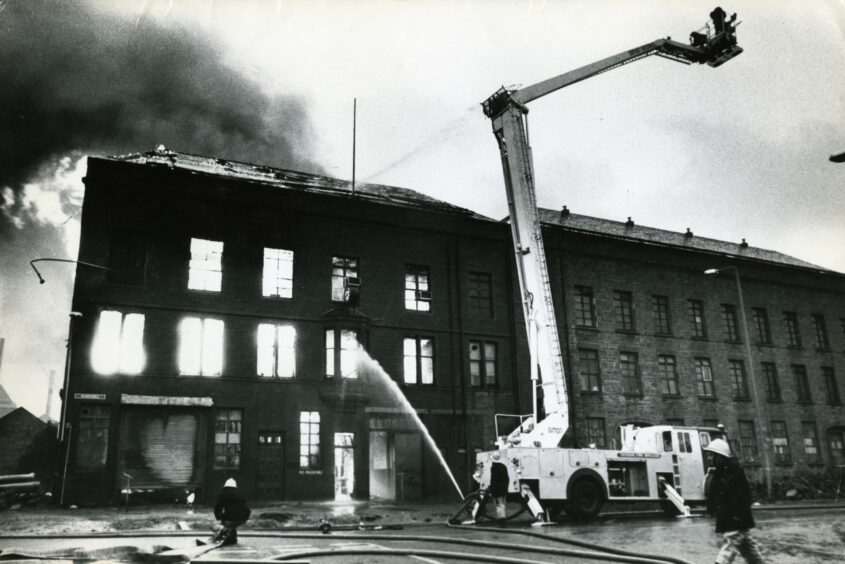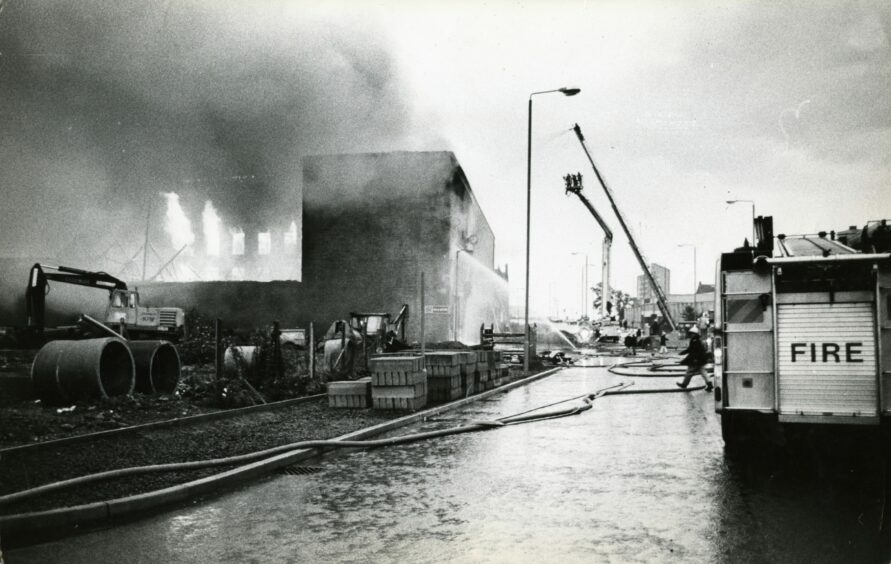
Time stood still as the historic Ashton Works in Dundee was reduced to a smouldering shell following a devastating fire 40 years ago.
An old clock hung broken from the second floor.
Its hands showed the time of 7.50pm when the fire was at its fiercest.
The £1.5 million damage was the equivalent of £6.4m in today’s money.
As firefighters worked to damp down the last of the burning embers, metal doors at the front of the building lay askew, buckled and twisted on their hinges by the heat.
Time was up for the 19th Century works — one of Dundee’s most historic buildings.
Ashton Works was part of the fabric of Dundee
Its origins extend back to 1832 when Edward Caird began the manufacture of cloth in a 12-loom shed at the site before the firm was taken over by his son James in 1870.
Under his leadership, Ashton Works was re-built, expanded and equipped with the latest machinery and would become one of Dundee’s most efficient jute mills.
A notable event in the history of Ashton Works came in July 1914 when King George V and Queen Mary laid the foundation stones of the Caird Hall.
This was actually done remotely by electronic signal from Ashton Works when the King pressed an emerald and the Queen a piece of jade to start the process.
The same emerald is now part of the Lord Provost’s chain.
The jute industry was hit by a series of booms and slumps in the 19th Century, before falling into decline in the 20th Century.
Ashton Works converted to making carpets before being bought out in 1981 by the Belgian carpet giant Beaulieu Tapis, which was based in Wielsbeke and Waregem.
The then Caird Carpets was closed down in October 1982 with the loss of 80 jobs amid claims and counter claims of poor industrial relations following a strike by employees.
The fire happened around 6.45pm on Friday September 2 1983.
More than 60 firefighters battled for more than three hours to contain the blaze.
But it was an impossible fight.
Ashton Works fire turned sky black
The Courier described the “pall of burning embers-filled smoke” which billowed from the building and all-consuming flames which were seen “from as far afield as Fife”.
It said: “Senior officers at the scene said the fire was so fierce that from the outset their only objective was containment.
“Crews from Carnoustie, Tayport and Forfar were called in to back up the efforts of units from all the fire stations in Dundee.
“In all, 10 jets and a turntable ladder and hydraulic platform were playing water on the inferno.
“The fire is believed to have started in a corner of a three-storey block occupied on a temporary basis by R. J. McLeod, contractors for the university bypass, and Tayside Regional Council’s Roads Department.
“At an early stage of the firefighting it was believed there were people in the building when the blaze began.
“The blaze was first reported at 6.45 and within minutes flames and a thick column of smoke towered over the building.
“Hundreds of onlookers gathered along the length of the as-yet unopened university bypass, caught up by the spectacle of the rapidly spreading flames.”
Windows blew outwards which were shattered by the scalding heat and the guttering melted as the fire climbed through the block.
Within half an hour the flames had broken through the roof timbers and were licking 50 feet in the air.
Relentlessly the fire spread along the length of the block, window by window, as firefighters concentrated on preventing the spread to its far end.
As the inferno raged, 12 firefighters wearing breathing apparatus, scaled ladders to the second floor of an unaffected part of the building only yards from where the fire raged “and plunged into the smoke after breaking their way through windows”.
Fresh flames took hold
Gas cylinders and diesel fuel for vehicles had been stored in the building.
The Courier said: “As the heat grew the area was rocked by two explosions and the roaring of gas flames, posing great danger to the battling firemen.
“After an hour, when the fire at the part of the building originally affected appeared to be dying down, fresh flames took hold at the other side of the L-shaped building.
“Again the progress of the flames could be followed window by window until the block was engulfed.
“Even through the thick pall of smoke, the flames glowed brightly as sections of the roof caved inwards.
“Firemen once more allowed the blaze in the affected section to run unchecked while they concentrated their efforts on preventing the spread to other parts of the buildings in the former mill complex.
“By 10pm the first of the units were stood down as the blaze was brought under control.
“The end wall of the block split and a 20-foot fissure appeared through which smoke seeped.
“A single storey section to the rear of the seat of the fire was also gutted in the outbreak.”
All roads leading to Ashton Works were closed off for the night while one firefighter from Tayport was taken to Dundee Royal Infirmary by ambulance where he received treatment for an eye injury before being released shortly afterwards.
Thankfully nobody else was hurt.
Why was the Ashton Works fire so intense?
Firemaster David Nicol explained why it might have spread so rapidly.
He said: “It has to be remembered that this was an old jute works and while it is now completely empty of machinery the floors are saturated with oil and all manner of things, which made the blaze more intense.”
The Courier said a 100-metre-square area of the main area of the building and a single-storey block were gutted while some 80% of the floor space was consumed by fire.
The scale of the damage became apparent the following morning.
Walls were cracked and bulging and loose masonry had been falling to the ground.
The building was subsequently demolished without ceremony.
Dr Kenneth Baxter from the University of Dundee Archive Services said: “Ashton Works was in its day one of Dundee’s most significant jute works and an important part of the city’s history.
“The younger Caird, who became Sir James in 1913 when he was awarded a baronetcy, is today best remembered as a great philanthropist who, among other gifts, provided Dundee with the Caird Hall and Caird Park.
“Yet his talents as businessman should not be overlooked.
“Craigie Works was acquired by Caird’s in 1905 and it and Ashton were soon considered to be among Dundee’s best equipped, and most efficient, mills.
“When Sir James Caird died in 1916, the firm’s mills included 14,000 spindles and 1,000 looms.”
Ashton Works was consigned to history following the 1983 blaze.
Almost.
One of the smaller rooms in the Caird Hall would later take its name.
Ashton Hall ensures its legacy lives on.


















Conversation